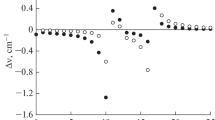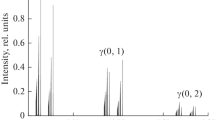Abstract
The vibrational and rotational terms of the \({{X}^{2}}\Pi \) and \({{A}^{2}}{{\Sigma }^{ + }}\) electronic states of the phosphorus oxide (PO) molecule are calculated, as well as the absorption spectrum corresponding to the \({{A}^{2}}{{\Sigma }^{ + }}({v}{\kern 1pt} ' = 0;J{\kern 1pt} ') - {{X}^{2}}\Pi ({v}{\kern 1pt} '' = 0;J{\kern 1pt} '')\) transition. The efficiency of laser excitation of PO molecules is estimated versus spectral parameters of the radiation.








Similar content being viewed by others
REFERENCES
H. Keller-Rudek, G. K. Moortgat, R. Sander, and R. Sorensen, “The MPI-Mainz UV/VIS spectral atlas of gaseous molecules of atmospheric interest,” Earth Syst. Sci. Data 5, 365–373 (2013).
M. O. Rodgers, K. Asai, and D. D. Davis, “Photofragmentation-laser induced fluorescence: A new method for detecting atmospheric trace gases,” Appl. Opt. 19 (21), 3597–3605 (1980).
M. O. Rodgers and D. D. Davis, “A UV-photofragmentation/laser-induced fluorescence sensor for the atmospheric detection of HONO,” Environ. Sci. Technol. 23 (9), 1106–1112 (1989).
S. T. Sandholm, J. D. Bradshaw, K. S. Dorris, M. O. Rodgers, and D. D. Davis, “An airborne compatible photofragmentation two-photon laser-induced fluorescence instrument for measuring background tropospheric levels of NO, NOx, and NO2,” J. Geophys. Res. D 95 (7), 161 (1990).
D. B. Galloway, J. A. Bartz, L. G. Huey, and F. F. Crim, “Pathways and kinetic energy disposal in the photodissociation of nitrobenzene,” J. Chem. Phys. 98 (3), 2107–2114 (1993).
G. W. Lemire, J. B. Simeonsson, and R. C. Sausa, “Monitoring of vapor-phase nitro compounds using 226-nm radiation: Fragmentation with subsequent NO resonance-enhanced multiphoton ionization detection,” Anal. Chem. 65 (5), 529–533 (1993).
D. B. Galloway, T. Glenewinkel-Meyer, J. A. Bartz, L. G. Huey, and F. F. Crim, “The kinetic and internal energy of no from the photodissociation of nitrobenzene,” J. Chem. Phys. 100 (3), 1946–1952 (1994).
D. D. Wu, J. P. Singh, F. Y. Yueh, and D. L. Monts, “2,4,6-trinitrotoluene detection by laser-photofragmentation-laser-induced fluorescence,” Appl. Opt. 35 (21), 3998–4003 (1996).
J. B. Simeonsson and R. C. Sausa, “A critical review of laser photofragmentation/fragment detection techniques for gas phase chemical analysis,” Appl. Spectrosc. Rev. 31 (1), 1–72 (1996).
V. Swayambunathan, G. Singh, and R. C. Sausa, “Laser photofragmentation-fragment detection and pyrolysis-laser-induced fluorescence studies on energetic materials,” Appl. Opt. 38 (30), 6447–6454 (1999).
N. Daugey, J. Shu, I. Bar, and S. Rosenwaks, “Nitrobenzene detection by one-color laser photolysis/laser induced fluorescence of NO (ν = 0–3),” Appl. Spectrosc. 53 (1), 57–64 (1999).
J. Shu, I. Bar, and S. Rosenwaks, “Dinitrobenzene detection by use of one-color laser photolysis and laser-induced fluorescence of vibrationally excited NO,” Appl. Opt. 38 (21), 4705–4710 (1999).
J. Shu, I. Bar, and S. Rosenwaks, “NO and PO photofragments as trace analyte indicators of nitrocompounds and organophosphonates,” Appl. Phys. B 71 (5), 665-672 (2000).
J. Shu, I. Bar, and S. Rosenwaks, “The use of rovibrationally excited NO photofragments as trace nitrocompounds indicators,” Appl. Phys. B 70 (4), 621–625 (2000).
T. Arusi-Parpar, D. Heflinger, and R. Lavi, “Photodissociation followed by laser-induced fluorescence at atmospheric pressure and 24°C: A unique scheme for remote detection of explosives,” Appl. Opt. 40 (36), 6677–6681 (2001).
D. Heflinger, T. Arusi-Parpar, Y. Ron, and R. Lavi, “Application of a unique scheme for remote detection of explosives,” Opt. Commun. 204 (1-6), 327–331 (2002).
C. M. Wynn, S. Palmacci, R. R. Kunz, J. J. Zayhowski, B. Edwards, and M. Rothschild, “Experimental demonstration of remote optical detection of trace explosives,” Proc. SPIE—Int. Soc. Opt. Eng. 6954, 695407–8 (2008).
T. Arusi-Parpar, S. Fastig, J. Shapira, B. Shwartzman, D. Rubin, Y. Ben-Hamo, and A. Englander, “Standoff detection of explosives in open environment using enhanced photodissociation fluorescence,” Proc. SPIE—Int. Soc. Opt. Eng. 7684, 76840 (2010).
C. M. Wynn, S. Palmacci, R. R. Kunz, and M. Rothschild, “Noncontact detection of homemade explosive constituents via photodissociation followed by laser-induced fluorescence,” Opt. Express 18 (6), 5399–5406 (2010).
C. M. Wynn, S. Palmacci, R. R. Kunz, and M. Aernecke, “Noncontact optical detection of explosive particles via photodissociation followed by laser-induced fluorescence,” Opt. Express 19 (19), 18671–18677 (2011).
S. M. Bobrovnikov and E. V. Gorlov, “Lidar method for remote detection of vapors of explosives in the atmosphere,” Atmos. Oceanic Opt. 24 (3), 235–241 (2011).
S. M. Bobrovnikov, A. B. Vorozhtsov, E. V. Gorlov, V. I. Zharkov, E. M. Maksimov, Y. N. Panchenko, and G. V. Sakovich, “Lidar detection of explosive vapors in the atmosphere,” Rus. Phys. J. 58 (9), 1217–1225 (2016).
S. M. Bobrovnikov, E. V. Gorlov, V. I. Zharkov, Yu. N. Panchenko, and A. V. Puchikin, “Two-pulse laser fragmentation/laser-induced fluorescence of nitrobenzene and nitrotoluene vapors,” Appl. Opt. 58 (27), 7497–7502 (2019).
S. M. Bobrovnikov, E. V. Gorlov, and V. I. Zharkov, “Evaluation of limiting sensitivity of the one-color laser fragmentation/laser-induced fluorescence method in detection of nitrobenzene and nitrotoluene vapors in the atmosphere,” Atmosphere 10 (11), 1–11 (2019).
S. M. Bobrovnikov, E. V. Gorlov, V. I. Zharkov, Yu. N. Panchenko, and A. V. Puchikin, “Dynamics of the laser fragmentation/laser-induced fluorescence process in nitrobenzene vapors,” Appl. Opt. 57 (31), 9381–9387 (2018).
J. M. St. Clair, T. F. Hanisco, E. M. Weinstock, E. J. Moyer, D. S. Sayres, F. N. Keutsch, J. H. Kroll, J. N. Demusz, N. T. Allen, J. B. Smith, J. R. Spackman, and J. G. Anderson, “A new photolysis laser-induced fluorescence instrument for the detection of H2O and NDO in the lower stratosphere,” Rev. Sci. Instrum. 79 (6), 064101-1–14 (2008).
K. Larsson, O. Johansson, M. Alden, and J. Bood, “Simultaneous visualization of water and hydrogen peroxide vapor using two-photon laser-induced fluorescence and photofragmentation laser-induced fluorescence,” Appl. Spectrosc. 68 (12), 1333–1341 (2014).
O. Johansson, J. Bood, M. Alden, and U. Lindblad, “Detection of hydrogen peroxide using photofragmentation laser-induced fluorescence,” Appl. Spectrosc. 62 (1), 66–72 (2008).
O. Johansson, J. Bood, M. Alden, and U. Lindblad, “Hydroxyl radical consumption following photolysis of vapor-phase hydrogen peroxide at 266 nm: Implications for photofragmentation laser-induced fluorescence measurements of hydrogen peroxide,” Appl. Phys. B 97 (2), 515–522 (2009).
K. Larsson, D. Hot, A. Ehn, A. Lantz, W. Weng, M. Alden, and J. Bood, “Quantitative imaging of ozone vapor using photofragmentation laser-induced fluorescence (LIF),” Appl. Spectrosc. 71 (7), 1578–1585 (2017).
K. Larsson, D. Hot, J. Gao, C. Kong, Z. Li, M. Alden, J. Bood, and A. Ehn, “Instantaneous imaging of ozone in a gliding arc discharge using photofragmentation laser-induced fluorescence,” J. Phys. D: Appl. Phys. 51 (13), 1–7 (2018).
W. Liao, A. Hecobian, J. Mastromarino, and D. Tan, “Development of a photo-fragmentation/laser-induced fluorescence measurement of atmospheric nitrous acid,” Atmos. Environ. 40 (1), 17–26 (2006).
S. R. Long, R. C. Sausa, and A. W. Miziolek, “LIF studies of PO produced in excimer laser photolysis of dimethyl methyl phosphonate,” Chem. Phys. Lett. 117 (5), 505–510 (1985).
S. E. Bisson, J. M. Headrick, T. A. Reichardt, R. L. Farrow, and T. J. Kulp, “A two-pulse, pump-probe method for short-range, remote standoff detection of chemical warfare agents,” Proc. SPIE—Int. Soc. Opt. Eng. 8018, 80180 (2011).
E. L. Hill and J. H. Van Vleck, “On the quantum mechanics of the rotational distortion of multiplets in molecular spectra,” Phys. Rev. 32 (2), 250–272 (1928).
R. K. Hinkley, J. A. Hall, T. Walker, and W. G. Richards, “Λ doubling in 2Π states of diatomic molecules,” J. Phys. B 5 (2), 204–212 (1972).
J. H. Van Vleck, “On σ-type doubling and electron spin in the spectra of diatomic molecules,” Phys. Rev. 33 (4), 467–506 (1929).
R. D. Verma and S. R. Singhal, “New results on the B2∑+, b4∑−, and X2Π states of PO,” Can. J. Phys. 53, 411–419 (1975).
G. Herzberg, Molecular Spectra and Molecular Structure. I. Spectra of Diatomic Molecules (D. van Nostrand company, Toronto, 1950).
S. Bailleux, M. Bogey, C. Demuynck, Y. Liu, and A. Walters, “Millimeter-wave spectroscopy of PO in excited vibrational states up to ν = 7,” J. Mol. Spectrosc. 216 (2), 465–471 (2002).
K. S. Rao, “Rotational analysis of the γ system of the PO molecule,” Can. J. Phys. 36 (11), 1526–1535 (1958).
R. D. Verma and S. S. Jois, “Emission spectrum of the PO molecule. Part IV. Spectrum in the region 7000–12000 A,” Can. J. Phys. 51 (3), 322–333 (1973).
B. Coquart, M. Paz, and J. C. Prudhomme, “Transition \({{A}^{2}}{{\Sigma }^{ + }}{\kern 1pt} - {\kern 1pt} {{X}^{2}}\Pi \) des molecules P16O et P18O. Perturbations de l’etat \({{A}^{2}}{{\Sigma }^{ + }}\),” Can. J. Phys. 53 (4), 377–384 (1975).
H.-P. Dorn, R. Neuroth, and A. Hofzumahaus, “Investigation of OH absorption cross sections of rotational transitions in the \({{A}^{2}}{{\Sigma }^{ + }}\), \(\upsilon {\kern 1pt} ' = 0 \leftarrow {{X}^{2}}\Pi \), \(\upsilon {\kern 1pt} '' = 0\) band under atmospheric conditions: Implications for tropospheric long-path absorption measurements,” J. Geophys. Res.: Atmos. 100 (4), 7397–7409 (1995).
L. A. Kuznetsova, N. E. Kuz’menko, Yu. Ya. Kuzyakov, and Yu. A. Plastinin, “Probabilities of optical transitions in electronic vibration-rotation spectra of diatomic molecules,” Sov. Phys.-Usp. 17 (3), 405–423 (1974).
I. Kovacs, Rotational Structure in the Spectra of Diatomic Molecules (Academic Kiado, Budapest, 1969).
E. E. Whiting, A. Schadee, J. B. Tatum, J. T. Hougen, and R. W. Nicholls, “Recommended conventions for defining transition moments and intensity factors in diatomic molecular spectra,” J. Mol. Spectrosc. 80 (2), 249–256 (1980).
E. E. Whiting, J. A. Paterson, I. Kovacs, and R. W. Nicholls, “Computer checking of rotational line intensity factors for diatomic transitions,” J. Mol. Spectrosc. 47 (1), 84–98 (1973).
K. N. Wong, W. R. Anderson, and A. J. Kotlar, “Radiative processes following laser excitation of the state of PO,” J. Chem. Phys. 85 (5), 2406–2413 (1986).
A. Y. Chang, M. D. DiRosa, and R. K. Hanson, “Temperature dependence of collision broadening and shift in the NO A ← X(0, 0) band in the presence of argon and nitrogen,” J. Quant. Spectrosc. Radiat. Transfer 41 (5), 375–390 (1992).
B. Edlen, “The refractive index of air,” Metrologia 2 (2), 12–80 (1966).
Funding
The work was supported by the Russian Science Foundation (project no. 20-79-10 297).
Author information
Authors and Affiliations
Corresponding author
Ethics declarations
The authors declare that they have no conflicts of interest.
Additional information
Translated by O. Ponomareva
Rights and permissions
About this article
Cite this article
Bobrovnikov, S.M., Gorlov, E.V. & Zharkov, V.I. Estimation of the Efficiency of Laser Excitation of Phosphorus Oxide Molecules. Atmos Ocean Opt 34, 302–312 (2021). https://doi.org/10.1134/S1024856021040047
Received:
Revised:
Accepted:
Published:
Issue Date:
DOI: https://doi.org/10.1134/S1024856021040047




